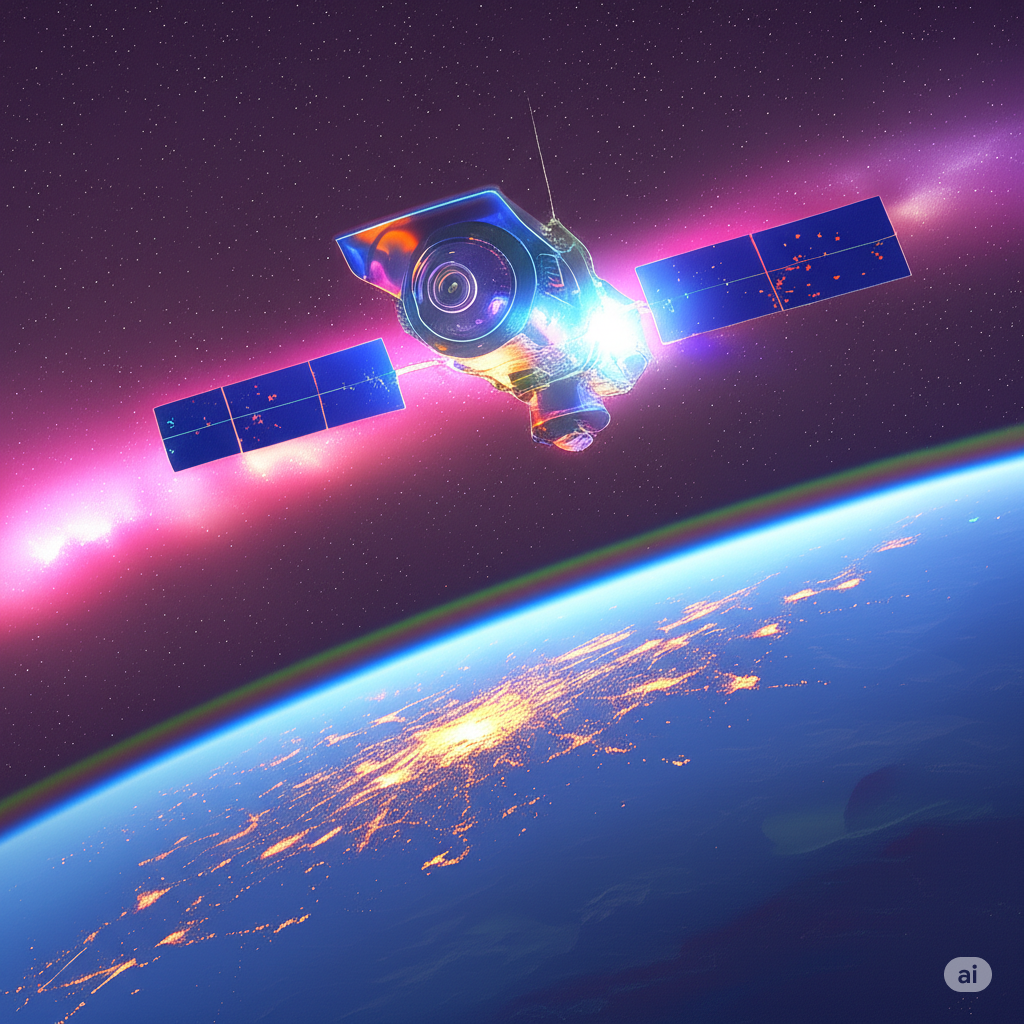Introduction
In the modern era, space is no longer just the realm of scientific exploration—it has become a strategic frontier with profound implications for national security. As countries strive to protect their borders and maintain geopolitical advantage, space-based surveillance has emerged as a critical component of national defense strategies. This technological capability allows governments to monitor activities across the globe in real-time, enhancing their ability to detect threats, conduct military operations, manage natural disasters, and enforce sovereignty.
This article explores the evolution, significance, applications, challenges, and future of space-based surveillance, with a special focus on how it influences the national security landscape, particularly for countries like India.
What is Space-Based Surveillance?
Space-based surveillance refers to the use of satellites and orbital technologies to gather data and monitor events on Earth. This includes tracking military movements, detecting missile launches, monitoring border activity, collecting weather data, and supporting communications.
The main types of satellites used in surveillance include:
- Reconnaissance Satellites: Used for imaging, mapping, and observing ground-based activity.
- Electronic Intelligence (ELINT) Satellites: Intercept electronic signals and communications.
- Signals Intelligence (SIGINT) Satellites: Capture radio, radar, and other signal-based data.
- Early Warning Satellites: Detect missile launches and nuclear activity.
- Navigation Satellites: Support military operations by enabling GPS-based tracking and targeting.
Historical Background
Cold War Origins
The concept of surveillance from space began during the Cold War. The United States and the Soviet Union deployed reconnaissance satellites to monitor each other’s military bases and nuclear facilities. Programs like the Corona project in the U.S. revolutionized space-based intelligence gathering.
Post-Cold War Developments
After the Cold War, other nations, including China, India, Israel, and members of the European Union, began developing satellite surveillance capabilities for both civil and defense purposes.
Today, over 80 countries operate or share access to Earth observation satellites, with many investing heavily in defense-oriented surveillance.
Applications of Space-Based Surveillance in National Security
1. Border and Coastal Surveillance
Satellites provide critical imaging of remote border regions, deserts, mountain passes, and coastal areas where traditional surveillance infrastructure is limited. In countries like India, with vast and porous borders, space-based monitoring enhances border security and counters infiltration.
2. Missile Launch Detection
Early-warning satellites equipped with infrared sensors can detect heat signatures from missile launches. This enables prompt response and intercept measures before the missile reaches its target, forming a key component of missile defense systems.
3. Maritime Security
India, with a strategic position in the Indian Ocean Region (IOR), uses satellites to monitor shipping lanes, track vessels, detect illegal fishing or smuggling, and respond to piracy threats.
4. Military Reconnaissance and Tactical Support
High-resolution satellites assist in mapping terrain, tracking enemy troop movements, planning air strikes, and coordinating ground operations with precision.
5. Communication and Navigation
Secure satellite-based communication and GPS services are vital for modern military operations, particularly in remote areas without terrestrial networks.
6. Disaster Management and Humanitarian Operations
During natural disasters, space-based imagery helps assess damage, locate survivors, and coordinate rescue operations—an essential aspect of national resilience.
Space-Based Surveillance and Strategic Deterrence
Surveillance satellites also serve as tools of strategic deterrence, demonstrating a nation’s ability to watch, analyze, and respond in near-real-time. The mere knowledge that a country possesses advanced imaging and detection capabilities can discourage hostile actions.
For instance:
- Detection of enemy military build-up can prompt diplomatic engagement or defensive mobilization.
- Satellite evidence can support a country’s claims in international disputes or UN briefings.
- In counterterrorism, satellites help locate training camps, communication hubs, and movement patterns of terrorist networks.
Major Global Players in Space Surveillance
1. United States
The U.S. operates a vast satellite surveillance network under the National Reconnaissance Office (NRO), along with support from NASA and the Department of Defense. Systems like SBIRS (Space-Based Infrared System) are essential for missile warning and battlefield awareness.
2. Russia
Russia’s space surveillance assets, maintained by Roscosmos and military agencies, include satellites for missile detection, radar imaging, and electronic intelligence.
3. China
China has rapidly expanded its space capabilities, launching surveillance satellites such as the Yaogan series for optical, radar, and signal intelligence. It integrates space assets into its military doctrine under the PLA Strategic Support Force.
4. European Union
The Copernicus Programme and national missions from France, Germany, and Italy contribute to Earth observation and defense monitoring.
5. Israel
Israel’s Ofek satellite series supports military surveillance, particularly in the Middle East region.
India’s Space-Based Surveillance Capabilities
India has significantly advanced its space surveillance capabilities over the past two decades, primarily through the Indian Space Research Organisation (ISRO) and the Defence Research and Development Organisation (DRDO).
1. Key Surveillance Satellites
- Cartosat Series: High-resolution imaging satellites for terrain mapping and reconnaissance.
- RISAT Series: Radar Imaging Satellites capable of night-time and all-weather surveillance.
- EMISAT: Launched in 2019, this satellite provides electronic intelligence for defense forces.
- GSAT and INSAT Series: Support secure communications for armed forces.
2. Defence Space Agency (DSA)
Formed in 2019, the DSA coordinates space-based military operations and integrates satellite data with ground-based command systems.
3. Integration with Maritime and Air Defense
Satellites support Indian Navy operations in the Indian Ocean and help the Indian Air Force with precision targeting and surveillance of airspace.
Challenges in Space-Based Surveillance
Despite its advantages, space-based surveillance faces several challenges:
1. Space Debris and Congestion
The growing number of satellites and space junk poses collision risks, threatening the continuity of surveillance missions.
2. Cybersecurity Threats
Satellites and their ground control systems can be hacked or jammed by hostile actors, leading to data loss or manipulation.
3. Cost and Technological Barriers
Developing and launching high-performance surveillance satellites require significant investment and technical expertise, often beyond the reach of developing countries.
4. Signal Delay and Resolution Limitations
While satellites provide wide coverage, the delay in image transmission and limited resolution for mobile targets can reduce real-time effectiveness.
5. Anti-Satellite (ASAT) Weapons
The militarization of space has led to the development of ASAT weapons. India, China, Russia, and the U.S. have tested such systems, making surveillance assets vulnerable to attacks.
International Laws and Treaties
1. Outer Space Treaty (1967)
Prohibits the placement of nuclear weapons or weapons of mass destruction in space but allows for peaceful use, including surveillance.
2. Transparency and Confidence-Building Measures (TCBMs)
Encourages states to share data and reduce the risk of misunderstandings related to space activities.
3. Space Debris Mitigation Guidelines
Developed by UN COPUOS and the Inter-Agency Space Debris Coordination Committee (IADC), these promote responsible satellite deployment.
Despite these frameworks, there is a growing need for comprehensive global treaties addressing military use of space-based surveillance and preventing space-based conflicts.
India’s Strategic Needs and Roadmap
To fully leverage space-based surveillance for national security, India must:
1. Expand Satellite Fleet
More high-resolution and radar-capable satellites are needed to provide continuous coverage across borders and maritime zones.
2. Improve Data Integration
Surveillance data from space must be seamlessly integrated with land, air, and cyber intelligence for timely decision-making.
3. Strengthen Space Command
India should continue developing a robust Space Command structure to coordinate defense space assets and build offensive and defensive space strategies.
4. Invest in Anti-Jamming and Cybersecurity
Secure encryption, satellite hardening, and cyber resilience must be prioritized to protect space assets.
5. Promote Indigenous R&D
Encourage private sector and academic collaboration to develop indigenous technologies for satellite sensors, payloads, and launch vehicles.
Future of Space-Based Surveillance
1. AI and Big Data Integration
Artificial Intelligence (AI) and machine learning will be used to analyze satellite imagery faster and more accurately, enabling predictive surveillance.
2. Micro and Nano Satellites
The use of small, low-cost satellites (CubeSats) in constellations can provide real-time, persistent surveillance.
3. Hyperspectral Imaging
This next-generation technology allows satellites to detect objects based on their chemical signatures—valuable in tracking camouflage or underground activity.
4. Quantum Communication
Quantum-encrypted satellite communication will enhance data security, reducing the risk of interception.
5. Space-Based Radar Networks
Integrated radar satellites will allow continuous surveillance irrespective of weather or lighting conditions.
Conclusion
Space-based surveillance has transformed the way nations secure their borders, monitor threats, and conduct military operations. For a country like India, which faces multifaceted security challenges across land, sea, and air, leveraging satellite technology is not just an option—it is a strategic necessity. The ability to see, analyze, and act from space provides a decisive edge in modern defense.
However, with this power comes the responsibility of ensuring that space remains a domain of peaceful, lawful, and cooperative activity. As surveillance technologies advance, India and other nations must navigate this new frontier with foresight, innovation, and commitment to global stability.
Summary Points
The future will see AI integration, quantum communication, and hyperspectral imaging enhancing space surveillance.
Space-based surveillance uses satellites for Earth observation, defense intelligence, and strategic monitoring.
Applications include border surveillance, missile detection, maritime tracking, and disaster management.
India has made significant progress with Cartosat, RISAT, EMISAT, and the Defence Space Agency.
Challenges include space debris, cybersecurity, high costs, and vulnerability to ASAT weapons.




